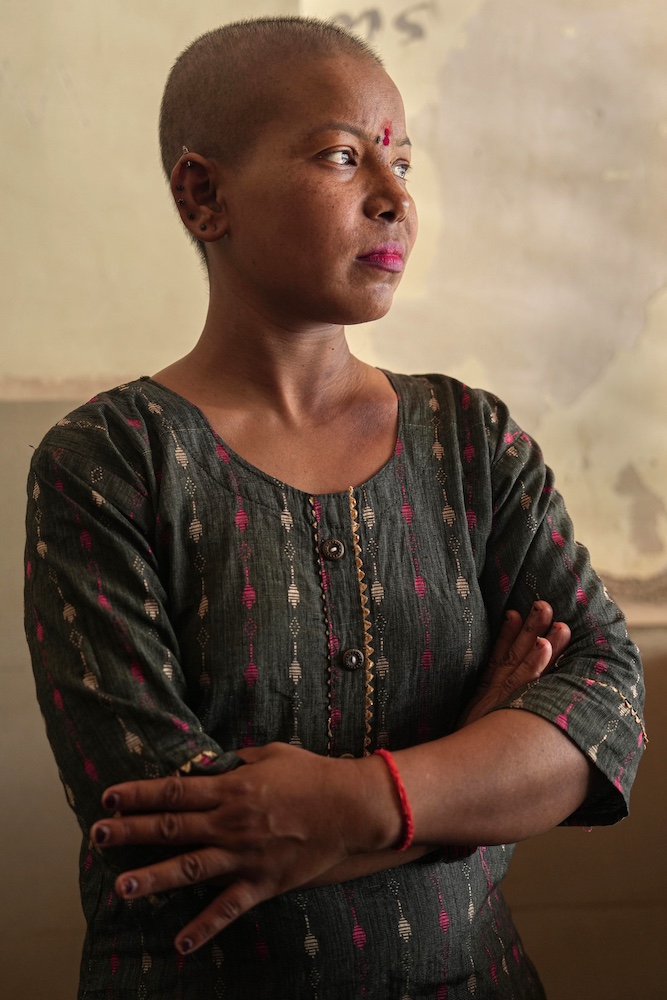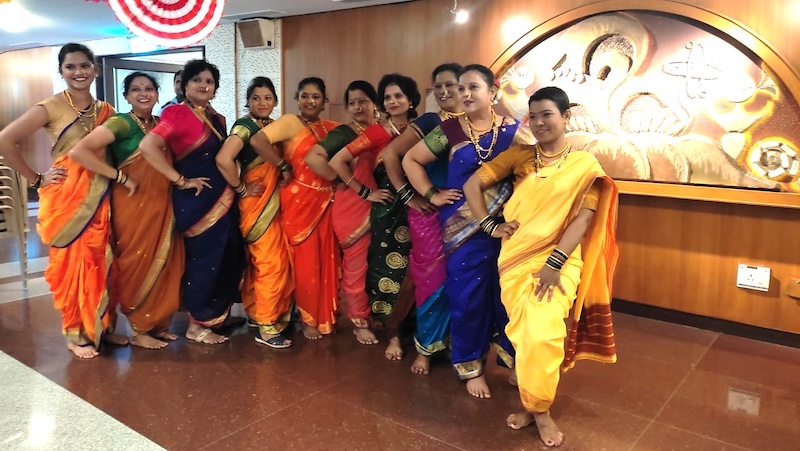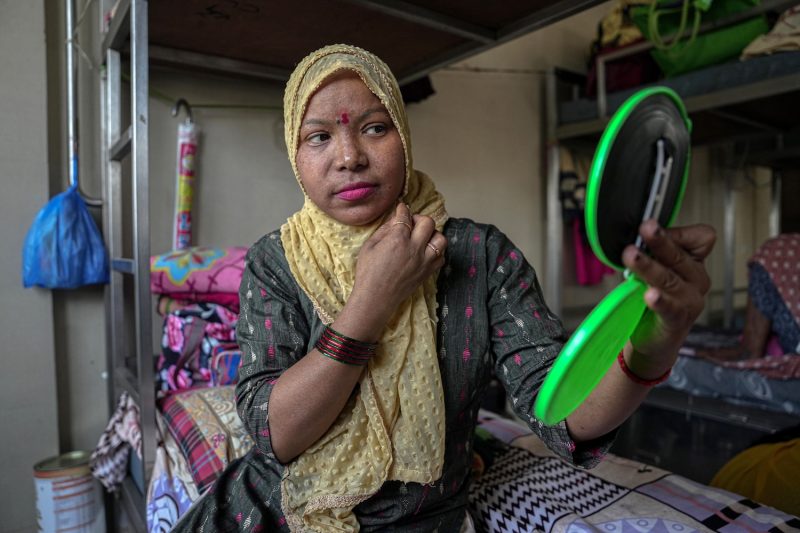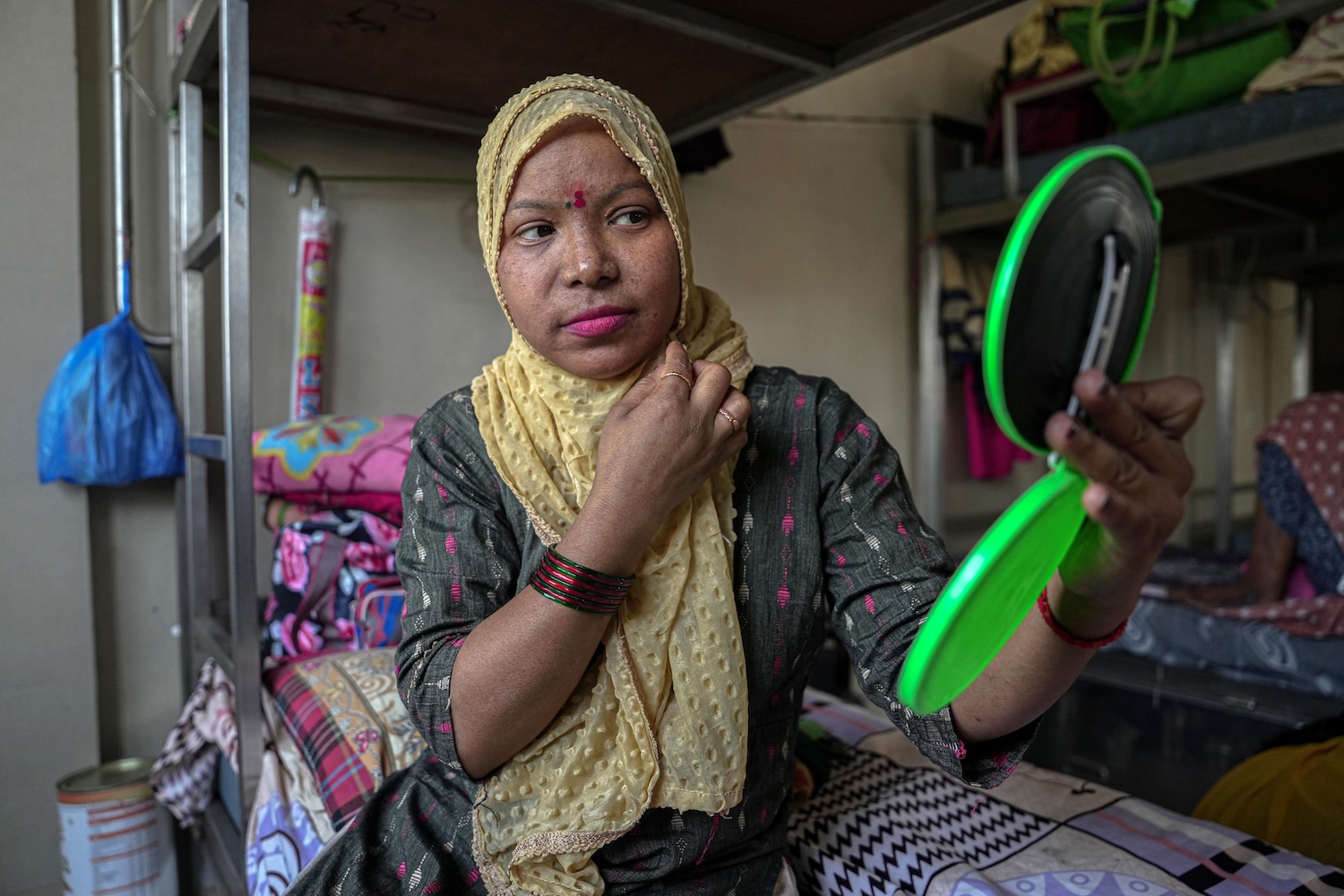There is not a dull moment when Tulasi Singh is around. She makes sure that the women’s hall on the fifth floor of the Gadge Maharaj Dharamshala, a subsidised hostel for cancer patients close to the Tata Memorial Hospital in Mumbai, India, is filled with laughter and chatter.
Tulasi, who is pictured above, getting ready to have her photo taken, is from Jalpaiguri in West Bengal. She has barely completed the fourth grade in school but does not lack confidence or charm. “I am like the Big Boss [an Indian reality show similar to Big Brother] in this place, I tell people what to do and they listen. I only do this to make sure everyone is happy, only then can you beat cancer,” she tells me, half serious and half joking.
When we first meet, Tulasi has been living in the hall for the last eight months since she was diagnosed with breast cancer, and she has dealt with her entire treatment on her own. Married at 22, she returned home within a few months, pregnant with her son. She never returned to her husband’s home because the couple had too many differences, she says. She lived with her ‘Bade papa’ and ‘Badi mummy’ – her uncle and aunt. She works at their home and they, in turn, take care of her and her 15-year-old son.
For each chemotherapy session, Tata Memorial Hospital requires the patient to bring a family member or friend with them. As Tulasi is alone, she asks one of the other caregivers staying in the hall to accompany her. She tells me that she didn’t face too many side-effects of the chemotherapy, and she is the one who rushes to help a patient get to hospital in an emergency. While her cousin sister came with her when she first came to Mumbai to get treated in Tata Memorial hospital, she left after 20 days. Her brother came later, but he would complain that she had ruined his life by asking him to accompany her to Mumbai. So Tulasi sent him back. Being alone was better, she said, especially once she was able to find her way around the city on her own.
Women are primary caregivers in families but when they deal with a cancer diagnosis, they often feel guilty or are made to feel like a burden to their families. Despite working tirelessly around the house – cooking, housekeeping, rearing children and looking after elderly family members – many women with cancer face neglect and abandonment by their families.
The 2023 report by the Lancet Commission on Women, Power and Cancer, drew attention to the raised risk of dying from cancer that women face due to factors related specifically to their gender. The authors highlight that, regardless of geographic region or economic resources, women are more likely than men to lack the knowledge and the power to make informed cancer-related healthcare decisions. They are also more likely than men to suffer financial catastrophe due to cancer, with dire consequences for their families, even if quality cancer care is available.
“Gender and related power imbalances increase women’s social vulnerability, which can impede their timely access to diagnosis and treatment”
They conclude that “Gender and related power imbalances increase women’s social vulnerability, resulting in lower health literacy, fear and experience of stigmatisation, and discrimination by the health system, all of which can impede their timely access to diagnosis, treatment, and quality cancer care,” and they recommend that governments and civil society should develop and implement gender-transformative strategies to mitigate barriers women face to getting their cancer diagnosed early and getting timely access to quality treatment and care.
Journalism that empowers
This article is a summary of a series of three articles by Cancerworld journalist Swagata Yadavar, written with support from the Pulitzer Center, that were recently published on the Indian website Behanbox (‘Voices of Sisters’), a digital media platform for gender journalism. The articles were also translated into Hindi and Marathi, with the translations being published on Khabar Lahariya – ‘the country’s only digital rural news network’ – and on Aksharnama a Marathi language online journalism site.
Survival chances skewed from childhood
Social beliefs favouring boys over girls remain deeply entrenched in India. They are reflected in rates of sex-selective abortions, child marriage, teenage pregnancy, and prevalence of domestic violence. The bias extends to all aspects of life including healthcare, and can be fatal.
A 2023 study of two population-based cancer registries shows disproportionately higher registration rates of cancer cases in boys than girls, with a ratio of 1.7:1 in the Delhi registry and 1.4:1 in the Chennai registry. Comparable statistics for a selection of high-income and low/middle-income countries are 1:1 in the US, 1.2:1 in the UK and Brazil, 1.3:1 in Uganda and 1.4:1 in Kenya. The authors argue that the disparity probably reflects which children get taken to the doctor when there are health concerns. “Symptomatic girls might not be brought forward for evaluation and diagnosis, leading to fewer cancer diagnoses in girls,” they suggest.
The sex disparity in registration rates was found to be more pronounced in northern India and in situations demanding greater financial commitment.
Looking at treatment rates for children who do get diagnosed with cancer, the authors did not find major disparities by sex, except for stem cell transplantation – a curative treatment for some blood cancers that costs around $18,000 in India. An analysis of hospital-based data from three cancer centres showed that, among 514 children who received this treatment, there were 2.8 boys treated for every 1 girl. Taking into account that fewer girls than boys will have been referred for treatment, the disparity was somewhat less, at between 1.33 and 1.36 boys for every 1 girl across the three hospitals.
Symptomatic girls might not be brought forward for evaluation and diagnosis, leading to fewer cancer diagnoses in girls
The authors point to the need to support efforts to enhance affordable healthcare for girls, with simultaneous efforts “to address the societal sex bias”.
Maya Prasad, Professor of Paediatric Oncology at the Tata Memorial Hospital in Mumbai, says their own hospital records show that the sex ratio for cancer registration has improved; it was 2.2:1 in 1985, 2.08:1 in 2015, and by 2023 it had reached to 1.8:1. A problem remains with parents abandoning treatment courses for both boys and girls, she says, but it happens more frequently with girls.
Vandana Mahajan, a cancer survivor and palliative care counsellor who works with the Lung Connect India Foundation patient support group, recalls the story of a three-year-old girl Simran (name changed) from a village in Maharashtra, who was diagnosed with retinoblastoma in both eyes. She was treated in Chennai when she was 10 months old, but the cancer recurred. It was incurable and Simran was in a lot of pain.
“Morphine is not an expensive drug, and I managed to arrange it for her,” says Mahajan, “but her mother told me that Simran’s grandmother would not give her money to travel or buy medicines for her, saying that she is a girl and will die anyways so why spend on her.”
Low public health priority
In India, breast cancer and cervical cancer account for almost one in three of all cancer deaths among women. Both cancers are amenable to early detection and treatment. National policies for population-based screening for oral, breast and cervical cancers have been in place since 2017. However, according to the most recent National Family Health Survey, which was published in 2022, only 0.6% of the target population have ever been screened for breast cancer, and only 1.2% for cervical cancer (Table 12.4).
A corollary of these low screening rates is that approximately half of all breast cancers in India are detected at stage 3 and 4. This accounts in large part for the high mortality rate: while almost nine out of ten people with breast cancer now survive at least five years in high income countries, in India only five out of ten survive that long.
Similar rates of late diagnosis also account for high mortality rates from cervical cancer. India bears one-fifth of the entire global burden of cervical cancer, and accounts for the highest number of deaths. Every seven minutes, one woman dies of cervical cancer in India. Yet not only are the screening rates abysmal, but the HPV vaccine, which has been available for more than two decades, is yet to be included in India’s free vaccination programme.
“If it were a cancer that killed one man every seven minutes, would it take so long for the vaccine and screening to be available?”
Mridu Gupta, who heads a non-profit organisation for cancer awareness, prevention, and early detection (CAPED), believes it is a gendered crisis. “If it were a cancer that affected men and killed one man every seven minutes, do you think it would take so long for the [HPV] vaccine and the screening to be available for all of them?” Women’s health is simply not backed by political will, and there is no urgent effort to increase awareness, she says.
With no effective implementation of screening programmes across most Indian states, awareness of cancer, its symptoms, and of the need to move quickly, remains very low, leaving women without the information that could save their lives.
Cervical cancer screening – a matter of political will
Tamil Nadu, a southern India state with a strong public health record, was the first and remains among the few Indian states that have implemented cervical screening in a systematic manner. A 2017 presentation by the state’s National Health Mission director shows that, between 2012 and 2017, 14.5 million women were screened using visual inspection by acetic acid (VIA). That equates to around 40% of the state’s population of women aged between 30 and 65 at that time. Of those who were screened, 3% were found to have suspicious lesions. However, no more-recent information is available. Other states, such as Punjab, Himachal Pradesh and Uttar Pradesh, have now started VIA screenings but the screening figures have not been shared.
A 2018 survey conducted among 1,000 rural women from the district of Wardha, in Maharashtra state, found that one-third of the respondents had never heard of breast cancer and fewer than one in ten women in both rural and semi-urban areas were aware of breast self-examination.
The same study also surveyed more than 200 women diagnosed with breast cancer, and found that more than half of them had a delay averaging three months between noticing the symptoms and their first consultation. Those three months’ average delays will have cost many of them their lives, according to a 2020 analysis published in the BMJ, which showed that a delay of one month in treating breast cancer increases the risk of death by 10%.
The study found that the most common reason for patients to delay seeking a diagnosis was painlessness of the breast lump and lack of knowledge about breast cancer. Even after diagnosis, many patients further delayed beginning treatment for reasons of cost. The resulting high mortality rate then contributes towards perpetuating the problem, by fuelling an erroneous perception that breast cancer is invariably fatal.
Ill-founded confidence in alternative therapies, combined with fears of standard therapies, can also deter or delay people from getting an early diagnosis. The authors of a 2009 study of 825 cancer patients in a public and a private hospital in Delhi found that 35% of patients had used traditional, complementary and alternative (TCAM) medicine, and many of them had delayed seeking help from mainstream healthcare. While half of non-users of TCAM sought immediate treatment after symptoms appeared, only one-third of those using TCAM did so. Furthermore, 12% of TCAM users waited six months or more after noticing cancer-related symptoms, while only 2.1% of non-users waited this long. Other studies have shown women and those with less education (did not finish primary education) also rely more on alternative treatment.
Tulasi’s story
 Educated only till fourth grade, and living with her uncle and aunt and her son, in a rural part of West Bengal, Tulasi Singh lacked the breast cancer awareness that she needed when, sometime in 2022, she noticed a white spot on her breast, which kept growing. After two months Tulasi noticed she was getting weaker and she finally consulted a homeopath in her village, who told her it was normal and gave her medicines for six months. During this time, the lump grew to the size of a lemon. It wasn’t until she felt an excruciating pain in her chest as she was drawing water from a well that she decided to visit a mainstream doctor. The doctor asked her why she waited for so long, and told her to go for a biopsy, which confirmed it as breast cancer. Tulasi and one of her relatives then travelled more than 2,000 km to the Apollo Hospital in Chennai – part of a large network of private hospitals – for treatment. When they realised that each chemotherapy session would cost Rs 75,000 (around US$ 900), they returned home. In March 2023 Tulasi found her way to the Tata Memorial Hospital, Mumbai, also more than 2,000 km from home, where high-quality treatment is available free or highly subsidised. By that time, her disease was so advanced that she needed 12 sessions of chemotherapy, followed by surgery and then 15 sessions of radiation. She completed her treatment in July 2024, having spent a total of Rs 100,000 (US$ 1190) on her treatment. Tulasi’s disease would have been cheaper, easier and quicker to treat, with more certainty about the outcome, if only she’d had the knowledge she needed, when she needed it, about breast cancer and where to get treatment.
Educated only till fourth grade, and living with her uncle and aunt and her son, in a rural part of West Bengal, Tulasi Singh lacked the breast cancer awareness that she needed when, sometime in 2022, she noticed a white spot on her breast, which kept growing. After two months Tulasi noticed she was getting weaker and she finally consulted a homeopath in her village, who told her it was normal and gave her medicines for six months. During this time, the lump grew to the size of a lemon. It wasn’t until she felt an excruciating pain in her chest as she was drawing water from a well that she decided to visit a mainstream doctor. The doctor asked her why she waited for so long, and told her to go for a biopsy, which confirmed it as breast cancer. Tulasi and one of her relatives then travelled more than 2,000 km to the Apollo Hospital in Chennai – part of a large network of private hospitals – for treatment. When they realised that each chemotherapy session would cost Rs 75,000 (around US$ 900), they returned home. In March 2023 Tulasi found her way to the Tata Memorial Hospital, Mumbai, also more than 2,000 km from home, where high-quality treatment is available free or highly subsidised. By that time, her disease was so advanced that she needed 12 sessions of chemotherapy, followed by surgery and then 15 sessions of radiation. She completed her treatment in July 2024, having spent a total of Rs 100,000 (US$ 1190) on her treatment. Tulasi’s disease would have been cheaper, easier and quicker to treat, with more certainty about the outcome, if only she’d had the knowledge she needed, when she needed it, about breast cancer and where to get treatment.
Low respect
Lack of awareness can be compounded by stigma. Women can feel uncomfortable talking – even with their husbands – about their private parts and symptoms of gynaecological cancers, such as excessive bleeding during periods, foul smell in vaginal discharge, lumps in the breast, and painful sex. This is why breast, ovarian, endometrial and cervical cancer are detected late, argues Mahajan, because women suffer the first symptoms in silence. “I have seen women, both in rural and urban India, who have detected a [breast] lump, and told no one about it till it reaches a point where there is an abscess, because they are not even empowered to take care of their own health.”
A 2021 study on cancer stigma in India found that a cancer diagnosis is often concealed by patients and their family members due to the many myths and beliefs related to the disease. One is that it is brought on by karma or ‘bad character’ and there is also the fear that cancer may be contagious. This leads to social isolation, gossip and verbal abuse and reduced marriage prospects for self or children and even physical separation within homes – with separate spaces, washing utensils, clothes and living spaces, experienced in cancer patients.
“There were a lot of fatalistic beliefs about cancer in the community which restricted cancer patients from leaving home or sharing their diagnosis for fear of being socially isolated,” says Ishu Kataria, Senior Public Health Researcher at RTI International’s Center for Global NCD, and one of the co-authors of the study. Especially in the case of cervical cancer, where there is an odorous discharge, people feel that the disease is communicable, she says.
Low family priority
Social norms around the role of women can also contribute to delayed diagnosis, argues Kataria, who was also a part of the Lancet Commission on Women, Power and Cancer. “Women do not prioritise their health, it’s always their family or children. Their position in the family along with lack of knowledge and power in their ability to make decisions are reasons why women present with cancer at a late stage,” she says.
While subjugating their own health needs to those of their family is to some extent characteristic of women the world over, the problem may be particularly acute in India. Comparative studies have shown the proportion of time spent in unpaid caregiving to be particularly high in India. It often starts at a young age, either as daughters or young wives, which contributes to low education levels, with all the consequences for low awareness, low earning opportunities and low power within the family.
When it comes to taking care of the elderly, chronically sick or disabled family members, it is usually a woman who does the job. Women worldwide carry out three-quarters of unpaid work, with the gender imbalance being greatest in low and middle-income countries. In India, the gap between men and women’s workload is particularly stark, with women accounting for almost 90% of unpaid household work, at a daily average of 4.4 hours, compared to just 0.5 hours for men.
Those studies highlight how critical women are as a caregiving force and how we need to value them, says Kataria, “which is certainly not being done now.”
When women are diagnosed with cancer, says Mahajan, the common concern in many families is: who will handle domestic work? In the course of her work as a palliative cancer counsellor, she recalls seeing many women handling household chores even when they are undergoing chemotherapy.
“One of them was a 60-year-old breast cancer patient who was undergoing rigorous chemotherapy but had to come to the hospital after cooking rotis (flattened Indian bread) for her 70-year-old husband,” she says. He had refused to eat the food cooked by his daughter-in-law.
“Women tend to believe that their place in the home is only secure for as long as they are considered to be ‘useful’ and available for sex”
The patriarchal system, especially in North India, treats women as expendable, she says. “During an awareness session for breast cancer patients, many came to me and said ‘bimari ka kuch hin, yeh bataiye ki hum humare husband ke saath so sakte hain ki nahi’ (the illness is fine, tell us if we can resume sexual activity or not).” Women tend to believe that their place in the home is only secure for as long as they are considered to be ‘useful’ to their husbands and available for sex.
The statistics on women being abandoned by their husbands after a cancer diagnosis show that these fears can be well-founded. Bhawna Sirohi, a medical oncologist specialising in gastrointestinal and breast cancer, and Medical Director, of the Balco Medical Centre in the state of Chhattisgarh, recalls that, in her three-decade-long career, she has sadly seen husbands abandoning their wives in the middle of or after cancer treatment. Women, by contrast, are usually very supportive of their husband’s cancer treatment. Sirohi recounted the case of a woman with fully curable breast cancer, whose husband refused to fund her treatment despite being very well-to-do, with a good job in Dubai.
“He said ‘Itne mein toh dusri lugai aa jaye gi’ (I can get another wife at this cost),” Sirohi says. She had to get the hospital to waive the fees, to help her. This attitude is far more common in lower socioeconomic classes, where a cancer diagnosis often means no-one to cook, care or look after the children, she adds, which often leads to the woman’s treatment being delayed or neglected.
As Sirohi points out, husbands abandoning wives with cancer is by no means a uniquely Indian issue. It’s a phenomenon she saw when she worked for a while in the UK. Indeed, a US study published in Cancer in 2009, found that, faced with a life-threatening illness, women were seven times more vulnerable to partner abandonment than men (20.8% vs. 2.9%). The study also showed that being abandoned had a negative impact, leading to greater use of antidepressants, less participation in clinical trials, frequent hospitalisations, and a lower likelihood of completing radiotherapy or dying at home. The impact on women in India could be more severe, given the higher levels of financial and social vulnerability.
Denied autonomy
The social position of women within the family also impacts on the control they have over decisions affecting their own health, argues Sirohi, with fathers, husbands or brothers stepping in to make critical calls (see also Indian Women Have No Say In Their Own Healthcare. Here Is How That Can Be Changed). “Even with the question of whether to have a mastectomy or a breast conserving surgery, a woman looks to a male member of the family to decide,” she says. “Even when I tell them that both cost the same, and the breast conserving surgery will give her the confidence and help her lead a regular life, the choice is made by men.” She says men sometimes reject the doctor’s recommendation for a breast conserving procedure for older women.
That disempowerment often extends to insisting women are never told that their diagnosis is terminal, says Mahajan, which men justify on the grounds that “they would not be able to bear it.” She recounts the case of a woman who had not long to live, and whose son refused to let Mahajan or the palliative physician speak about it, saying he thought she would lose hope.
“Shouldn’t she know that she is approaching death and complete unfinished business – write a will, distribute her assets and say her goodbyes?” Mahajan asks. As the mother was dying in the intensive care unit, she told Mahajan that her son would put a stop to all talk of death and inheritance with the admonishment: “Don’t speak about it, you will get better.”
Women are as strong or as weak as men are on these matters, making peace with the idea of impending death after the initial shock, says Mahajan, who cites the example of a dentist – unmarried – who knew about the terminal state of her lung cancer, but decided to stop chemotherapy. She chose to use her remaining strength to trek the Valley of Flowers in the western Himalayas – her lifelong dream.
“Women are as strong or as weak as men are on these matters, making peace with the idea of impending death after the initial shock”
In many ways, the women’s hostels that provide affordable shelter for women undergoing treatment at the Tata Memorial Hospital have the advantage of offering women a space where they can support one another and feel less constrained by the social expectations within their family setting. In the case of Tulasi, she even sent home the members of her family who had reluctantly agreed to accompany her to this massive city more than 2,000 km away. With almost no education, or status, or money, Tulasi showed she could navigate through her own cancer journey largely relying on her own resources.
She stayed in Gadge Maharaj Dharamshala till the end of her treatment in July 2024. By that time, Tulasi had not been home for a year and four months, but she had made the women’s hall her home. All the other cancer patients and their families became her family – she laughed, counselled and roamed the city with them. She managed to befriend everyone she met – nurses, social workers, security guards, and through them, she found work. For more than a month, from 10am to 6pm every day, Tulasi painted earthen lamps as part of a vocational work project provided by the Indian Cancer Society, and she is proud of having earned for her effort.
Despite not knowing how to read and write, she managed to raise Rs 90,000 (US$ 1,072) from various charitable trusts, which funded most of her treatment. From her aunt, she only asked for money for food and housing. “Kuchh bhi mushkil nahin, poochh poochh kar sab kar sakte hai,” she says (It is not hard, you figure things out by asking others).
When we last talked, Tulasi was set to do some sight-seeing with other patients and their families before she headed home. She was leaving for Shani Singnapur, a temple town in Maharashtra. “Chalti ka naam zindagi hai, didi” she told me, (Life is about moving on).
That she is able to do so speaks to her unshakeable sense of her own personal strength, despite the many ways in which society deprives her, and women like her, of the power conferred by status, education, and the ability to earn. Cancer control policies will need to recognise and address these power imbalances if they are to ensure that all women have the knowledge, agency and access to services that they need to protect themselves.

The opening illustration is by Afzal Adeeb Khan.
The three original articles summarised in this piece were supported by the Pulitzer Center.












